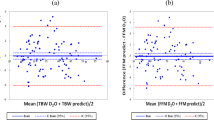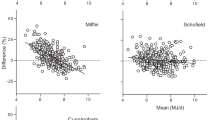Abstract
Objectives: The aims of this study were: (a) to generate regression equations for predicting the resting metabolic rate (RMR) of 18 to 30-y-old Australian males from age, height, mass and fat-free mass (FFM); and (b) cross-validate RMR prediction equations, which are frequently used in Australia, against our measured and predicted values.
Design: A power analysis demonstrated that 38 subjects would enable us to detect (α=0.05, power=0.80) statistically and physiologically significant differences of 8% between our predicted/measured RMRs and those predicted from the equations of other investigators.
Subjects: Thirty-eight males (X̄±s.d.: 24.3±3.3 y; 85.04±13.82 kg; 180.6±8.3 cm) were recruited from advertisements placed in a university newsletter and on community centre noticeboards.
Interventions: The following measurements were conducted: skinfold thicknesses, RMR using open circuit indirect calorimetry and FFM via a four-compartment (fat mass, total body water, bone mineral mass and residual) body composition model.
Results: A multiple regression equation using the easily measured predictors of mass, height and age correlated 0.841 with RMR and the SEE was 521 kJ/day. Inclusion of FFM as a predictor increased both the R and the precision of prediction, but there was virtually no difference between FFM via the four-compartment model (R=0.893, SEE=433 kJ/day) and that predicted from skinfold thicknesses (R=0.886, SEE=440 kJ/day). The regression equations of Harris & Benedict (1919) and Schofield (1985) all overestimated the mean RMR of our subjects by 518–600 kJ/day (P<0.001) and these errors were relatively constant across the range of measured RMR. The equations of Hayter & Henry (1994) and Piers et al (1997) only produced physiologically significant errors at the lower end of our range of measurement.
Conclusions: Equations need to be generated from a large database for the prediction of the RMR of 18 to 30-y-old Australian males and FFM estimated from the regression of the sum of skinfold thicknesses on FFM via the four compartment body composition model needs to be further explored as an expedient RMR predictor.
Sponsorship: Australian Research Council (small grants scheme).
European Journal of Clinical Nutrition (2001) 55, 145–152
This is a preview of subscription content, access via your institution
Access options
Subscribe to this journal
Receive 12 print issues and online access
$259.00 per year
only $21.58 per issue
Buy this article
- Purchase on Springer Link
- Instant access to full article PDF
Prices may be subject to local taxes which are calculated during checkout
Similar content being viewed by others
Author information
Authors and Affiliations
Contributions
Guarantor: GE van der Ploeg.
Contributors: GEP, SMG and ACM recruited the subjects, collected and analysed the data and helped to write the paper; RTW conceived the study, secured the research funding, supervised the project and wrote the paper; JPK helped to write the paper; BEC supervised the DXA scans.
Corresponding author
Rights and permissions
About this article
Cite this article
van der Ploeg, G., Gunn, S., Withers, R. et al. Predicting the resting metabolic rate of young Australian males. Eur J Clin Nutr 55, 145–152 (2001). https://doi.org/10.1038/sj.ejcn.1601125
Received:
Revised:
Accepted:
Published:
Issue Date:
DOI: https://doi.org/10.1038/sj.ejcn.1601125
Keywords
This article is cited by
-
New equations to estimate resting energy expenditure in obese adults from body composition
Acta Diabetologica (2018)
-
Inclusion of fish or fish oil in weight-loss diets for young adults: effects on blood lipids
International Journal of Obesity (2008)
-
Interindividual variability in sleeping metabolic rate in Japanese subjects
European Journal of Clinical Nutrition (2007)
-
Additional anthropometric measures may improve the predictability of basal metabolic rate in adult subjects
European Journal of Clinical Nutrition (2006)
-
Impact of indexing resting metabolic rate against fat-free mass determined by different body composition models
European Journal of Clinical Nutrition (2004)



